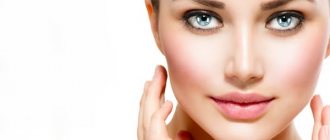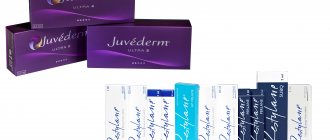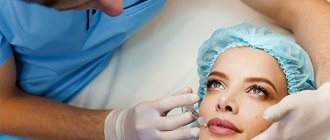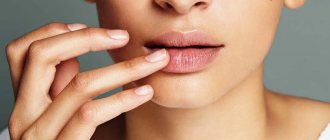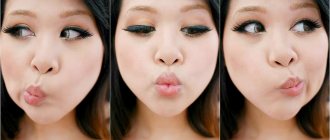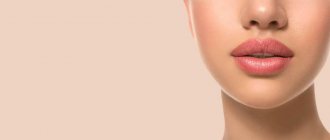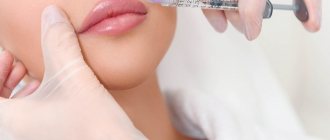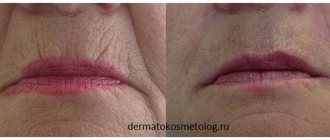Contour plastic surgery will help eliminate folds on the cheeks, make the cheeks more toned and the cheekbones more pronounced.
Maria Kuroedova
Cosmetologist with more than 10 years of experience
Ask a Question
The harmony and youth of the face significantly depend on how smooth and elastic the cheeks are.
Cheek contouring is a fast, safe, non-surgical method of creating a more perfect, clear, youthful facial contour.
Facial contouring
A non-surgical technique for correcting imperfections and age-related changes by injecting special preparations (fillers) under the skin of problem areas is called contour plastic surgery.
The technology is suitable for treating mild to moderate signs of aging: fine lines, expression lines, sagging and dry skin. This excellent alternative to surgery helps to correct the shape of the face, correct the shape and volume of the lips, get rid of bags under the eyes, change the proportions of the face, sharpen the contours of the chin and much more. Contour plastic surgery is acceptable from the age of majority. The technique is successfully used by both women and men, regardless of age. Young girls who keep up with fashion often turn to cosmetologists. Such patients want to make their appearance more expressive: plump their lips, change the shape of their chin, raise their cheekbones.
Experts distinguish the following main types of contour plastic surgery (depending on the areas requiring changes):
- CP of the upper third of the face.
- CP of the middle front part.
- CP of the lower third of the face.
- KP neck and décolleté.
This group includes corrections: forehead, brow ridge, upper eyelid, temples, cheekbones. Depending on the need, the drug can be injected into all or one problem area. The results of the manipulations can be: smoothing of creases between the eyebrows, straightening of deep horizontal furrows on the forehead, enlargement of the cheekbones, restoration of volume in the temples, disappearance of facial wrinkles and depressions in the periorbital area.
The procedure is aimed at eliminating nasolabial folds and combating purse-string wrinkles in the mouth area. At the individual request of the client, it is possible to adjust the shape and volume of the lips, as well as eliminate their asymmetry (if any).
In this area, work is carried out to model the contour, eliminate imperfections of the chin, and fill wrinkles in this area with fillers.
The cosmetologist introduces the gel to smooth out horizontal (rings of Venus) and vertical wrinkles on the neck, as well as to normalize the relief of the skin of the décolleté.
For some aesthetic defects and degenerative involutional processes, to normalize the condition, the introduction of fillers is indicated not only in problem areas. Plastic surgery should also be carried out in other areas in which pronounced changes may not be observed. For example, when restoring the volume of sunken cheeks, to create proportionality, fillers are additionally installed on the temples and cheekbones.
Fillers for facial contouring
Fillers are dermal fillers that have a gel consistency of varying densities. They are introduced into problem areas and fill the voids there, thereby smoothing the surface of the integument. The main parameters that fillers should have:
- biological compatibility. The drugs should not cause immune reactions from the body (allergies, swelling, rejection);
- biological degradability (biodegradation). The components of the compositions should be broken down and eliminated naturally over time;
- lack of migration: not acceptable if the gel spreads over the tissues.
Depending on the composition, the duration of action of the drug varies. It can last from 6 months to several years. There are the following types of fillers (based on the main ingredient of the drug):
- Hyaluronic (Juvederm, Restyline, Belotero and others).
- Collagen (Cosmoderm, Cosmoplast, etc.).
- Mineral, based on calcium hydroxyapatite (Radiesse, Delice Hydroxy).
- Polymilk (Sculptra, AestheFill, Ollex Professional).
The polysaccharide non-sulfonated glycosaminoglycan is found naturally in all tissues of the body. Therefore, administered drugs based on this substance are absolutely biologically compatible. Hyaluronate is subject to gradual destruction when exposed to the enzyme hyaluronidase. It is removed from the body completely, without any residue. Such fillers have a high ability to retain water molecules, due to which they act as a humectant and create a liquid depot for a long period of time. In addition, HA stimulates neocollagenogenesis, improves blood circulation and lymphatic drainage.
This type of dermal filler is made from an animal protein called collagen. These gels promote the stimulation of metabolic processes and promote better production of one's own fibrillar proteins, which form a natural framework that maintains tissue in a taut state. The negative aspects of collagen fillers are: rapid biodegradation (about 6 months) and the possibility of reactions from the body in the form of allergies and rejection.
This mineral is composed of calcium and phosphate ions, which are present in the bones of any organism. Its biocompatibility is beyond doubt. It is non-toxic and does not cause sensitization. The effect of drug administration is long-lasting: 1.5 - 2 years. They are widely used to camouflage scars and scars.
Poly-L-lactic acid is a synthetic polymer of polylactic acid. It decomposes very slowly (2 - 5 years) to water and carbon. When introduced under the skin, the crystals become overgrown with collagen, forming a dense new framework that supports the skin structures. Promotes the production of glycosaminoglycan, triggers the processes of rejuvenation of the cellular and intercellular composition of the dermis.
The filler that is suitable for the patient should be selected by the doctor, based on the degree of dermatological changes and the individual characteristics of the client.
Indications and contraindications for facial contouring
The procedure is recommended in the presence of the following conditions:
- age and expression wrinkles;
- nasolabial, nasolacrimal folds, glabellar folds, purse-string wrinkles in the perioral area;
- asymmetrical facial features;
- excessively thin lips;
- blurred oval face;
- “rings of Venus” and vertical wrinkles on the neck;
- uneven neckline relief;
- drooping cheeks, double chin;
- poorly defined cheekbones;
- dark circles and bags in the periorbital zone;
- patient's aesthetic preferences.
Facial contouring
can be combined with other cosmetic procedures. Therefore, experts often recommend comprehensive solutions to problems. Such therapy will improve the final result, and in many cases will accelerate its achievement. In certain circumstances, it is recommended to replace contour plastic surgery with another aesthetic procedure, or to postpone it. This decision may arise if the patient has:
- pregnancy or lactation;
- cancer;
- diabetes mellitus;
- aggravated chronic disease;
- allergies to filler components;
- previously performed with permanent filler;
- autoimmune pathologies;
- hemostasis disorders.
Modeling cannot be performed in case of acute respiratory diseases or skin inflammations. If you have menstrual days, you should wait until they end.
Cheekbone modeling
Instead of mandibuloplasty, there is surgery to install implants in the cheekbone area.
This is one of the most popular minimally invasive procedures today. Everyone does it: from 18 to 80 years old. (For comparison, mandibuloplasty can be performed no earlier than 23–25 years of age.) At a young age, people decide to undergo this procedure in order to achieve clearly defined cheekbones, like those of Instagram stars, and to make facial features more attractive. In adulthood - to tighten sagging tissues and thereby smooth out nasolabial folds, lift the corners of the lips, and restore the oval of the face. That is, correction of the zygomatic zone with filler alone can solve several problems at once!
Features and stages of the contouring procedure
Contour plastic surgery does not require hospitalization and is performed on an outpatient basis in an aesthetic medicine clinic. Only certified and specialized dermatocosmetologists are allowed to perform the procedure. All manipulations are carried out during one session. If complex therapy is necessary, the doctor’s office will have to be visited several times.
Preparations used for sculpting must have a quality certificate and a certificate of passing dermatological control. The duration of the procedure depends on the amount of work: from 30 to 60 minutes. Procedure steps:
- Preparation.
- Consultation with a dermatocosmetologist.
- Makeup removal and skin disinfection.
- Application anesthesia.
- Carrying out modeling plastic surgery.
- Light manual massage.
- Applying a mask.
24 hours before injections, you must avoid physical activity and alcohol consumption. If the patient is taking medications that reduce blood clotting, they must be discontinued 10-14 days before the simulation (only after consultation with a specialized specialist). To prevent herpes, a cosmetologist may prescribe antiviral medications.
During the appointment, the doctor will collect a detailed medical history, make sure there are no contraindications, and determine the need for injections. After which the optimal filler will be selected and its dosage determined.
Makeup and impurities are removed with specially selected cosmetics. Standard antiseptics (miramistin, chlorhexidine) are used for disinfection.
Lidocaine cream or spray is most often used as an anesthetic.
The doctor injects the drug along a pre-planned contour. The filler is injected intradermally, subcutaneously, supraperiostally, using special thin long needles or cannulas. At the end of the administration, the area is re-disinfected.
By massaging, the specialist helps the gel to be distributed more evenly.
Moisturizing and regenerating preparations help the skin to calm down, “come to its senses” after the intervention, and eliminate hyperemia.
Upon completion of all manipulations, the patient will receive a card describing the procedure and the drug used to perform the procedure. If necessary, the doctor will set a date for a re-appointment and provide recommendations for caring for the skin treated with fillers.
Non-surgical rhinoplasty
Instead of surgical rhinoplasty
Today, those with small humps and flat noses only need to spend half an hour visiting a cosmetologist to get the perfect profile. Fillers can smooth out unevenness and correct the shape: for example, make the bridge of the nose higher and thinner. Of course, only a plastic surgeon can make the nose significantly smaller or straighten a deviated septum for normal breathing. But if you are concerned about small aesthetic imperfections, we recommend that you first contact a cosmetologist. During a personal consultation, they will tell you what is best to do.
Tips for home care of the dermis after the procedure
After contouring, the following are possible:
- painful sensations at the injection sites some time after the procedure (1 - 2 days);
- hyperemia of the dermis at the sites of drug administration (during the first day);
- petechiae (up to 5 days after the procedure);
- hematoma (in case of injury to a large vessel), which completely resolves in 10-14 days;
- swelling of soft tissues in the area of drug administration (2-5 days).
For speedy rehabilitation and elimination of symptoms, it is necessary to follow the recommendations of the cosmetologist:
- on the first day, every 2.5 - 3 hours, treat the injection sites with an antiseptic and apply ice to the filler injection sites;
- use regenerating creams with panthenol or aloe vera;
- Do not take blood thinners or alcohol for 5 - 7 days;
- Apply protection against ultraviolet rays to your skin (before leaving the house).
Benefits of facial contouring
Contour plastic
facial has a number of advantages compared to other types of procedures:
- safety: all drugs undergo strict control;
- painlessness: anesthetics are used to eliminate discomfort;
- short rehabilitation period: from 7 to 14 days (depending on individual characteristics);
- long-term effect: on average up to 1.5 - 2 years (due to the composition of the drug);
- the result is noticeable immediately after the procedure.
Contour plastic surgery is an excellent alternative to surgery. With proper care, it gives a long-lasting and lasting effect. Due to the high compatibility of fillers with human tissue, the procedure is safe for health and extremely rarely causes side effects. A large selection of gels makes the procedure accessible to a wide range of consumers.
Until recently, cosmetology could offer only 2 types of drugs.
- Fillers based on hyaluronic acid (from the English word fill - fill): Restylane, Perlane, Juviderm, Surgiderm, Glytone. These safe gels are used to replenish lost volume - to smooth out wrinkles, nasolabial folds, and to increase the volume of lips and cheekbones. The effect lasts on average 3-6 months.
- collagen-stimulating fillers such as Sculptra and Radiesse. These newly created drugs are unique. They stimulate the skin's production of its own collagen. Therefore, the rejuvenating effect from their introduction does not disappear after the degradation of the gel itself and is guaranteed by the manufacturers for up to 2 years !
Expert commentary
“From overseas internships in France and the Hollywood Hills, we bring back the most effective techniques for our clients.
Therefore, we are able to offer you the same programs that help modern stars, firmly on strict diets, always have fresh young faces, smooth, blooming skin and radiant eyes.”

